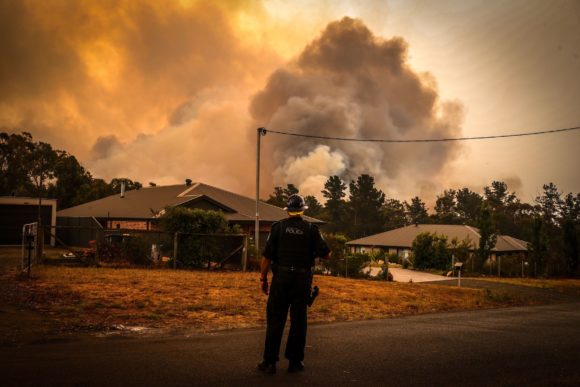The New South Wales and Victorian state governments will coordinate the clean-up of insured and uninsured residential and commercial properties destroyed in the deadly wildfires.
Under the plan, the states will appoint major contractors to do the work, which will include the clearing of asbestos-contaminated and fire-impacted materials, dangerous debris and trees, and the removal of concrete slab foundations.
Victoria’s Minister for Police and Emergency Services, Lisa Neville, told a press conference Sunday there are still 14 active bushfires burning in the state, which has “lost 396 residential properties.”
More than 1,300 firefighters are on the ground today across 69 firegrounds in NSW. 19 fires are still yet to be contained. Crews are trying to strengthen containment lines with assistance from heavy machinery and aircraft before conditions increase during the week.
While rain in the past few days has helped tame conflagrations, the fire season isn’t over yet. The first of four large airtankers arrived in Australia from the U.S. Saturday morning to boost aerial firefighting capability during the ongoing bushfire emergency.
The Insurance Council of Australia reported claims between Nov. 8 and Jan. 17 had reached A$1.41 billion ($970 million). That’s up 42% from Jan. 10.
“Cleaning up eligible destroyed properties will ensure that these costs are not deducted from funds available under residents’ insurance policies for rebuilding,” New South Wales Deputy Premier John Barilaro said Saturday.
Steven Lam, a Bloomberg Intelligence insurance analyst, said total insurance losses for Australia’s 2019-20 bushfires could reach billions of dollars.
“The key cause was the surge in number of cases, up 45% to 16,380. Whilst the cost per claim stabilized at A$86,000, it may still climb higher when commercial claims come in,” he said.
The catastrophic blazes have claimed 28 lives, killed an estimated 1 billion animals and have destroyed more than 2,700 homes as an area almost the size of England burned.
(Updates with Victoria joining clean-up from first paragraph.)
Was this article valuable?
Here are more articles you may enjoy.


 Amazon Ignored Its Own Worker Safety Studies, Senate Report Says
Amazon Ignored Its Own Worker Safety Studies, Senate Report Says  Here’s a Look at the $100 Billion in Disaster Relief in the Government Spending Bill
Here’s a Look at the $100 Billion in Disaster Relief in the Government Spending Bill  AI Focal Point of Cybersecurity Outlook for 2025, Says Experian
AI Focal Point of Cybersecurity Outlook for 2025, Says Experian  Advocacy Groups Ask FIO to Release Homeowners Insurance Data Collected by NAIC
Advocacy Groups Ask FIO to Release Homeowners Insurance Data Collected by NAIC 